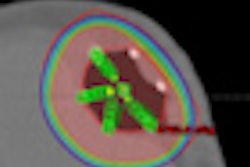Breast cancer patients who undergo breast-conserving surgery and then get accelerated partial-breast irradiation (APBI) with 3D external-beam radiation therapy (EBRT) have worse cosmetic outcomes than those who receive whole-breast irradiation, concluded research presented at the American Society for Radiation Oncology (ASTRO) meeting.
Dr. Timothy Whelan, professor of radiation oncology at McMaster University and a radiation oncologist at Juravinski Cancer Centre, reported interim toxicity results from the multicenter Randomized Trial of Accelerated Partial-Breast Irradiation (RAPID).
The study was designed to compare 3D conformal radiation therapy to standard whole-breast irradiation in breast cancer patients following breast conservation surgery. The primary outcome was to evaluate ipsilateral breast tumor recurrence, while a secondary outcome was to assess adverse cosmetic outcomes.
The study included 2,135 women older than age 40 who had invasive or noninvasive breast cancer smaller than 3 cm in size. The patients received treatment between February 2006 and July 2011, and they were randomized into two groups:
- APBI with 3D conformal radiation therapy of 38.5 Gy in 10 fractions twice daily
- Whole-breast irradiation of 50 Gy in 25 fractions or 42.5 Gy in 16 fractions, given once daily
Some of the patients receiving whole-breast irradiation also were prescribed a boost at the end of their treatment.
Adverse cosmetic outcomes were rated as fair or poor using the European Organisation for Research and Treatment of Cancer (EORTC) Cosmetic Rating System. Toxicities were reported using the U.S. National Cancer Institute (NCI) Common Terminology Criteria for Adverse Events 3.0.
Cosmesis was assessed by a trained study nurse and the patient prior to treatment, and at three and five years following completion of treatment. Cosmesis was also assessed by a trained panel of radiation oncologists unaware of treatment allocation using digital photographs.
The study is still under way; however, an interim safety analysis based on nurse-assessed adverse cosmesis was performed as planned after a median follow-up of 2.5 years.
At three years post-treatment, 850 patients had been assessed by nurses. Thirty-two percent of patients were found to have adverse cosmesis with APBI, comparison with 19% of patients treated with whole-breast irradiation.
Oncologists and patients provided similar assessments in the rate of observed adverse cosmesis with APBI or whole-breast irradiation, according to Whelan. Grade 1 and 2 late radiation toxicities, such as breast induration, were greater in the group receiving APBI compared to the whole-breast irradiation group. Grade 3 and 4 toxicities were rare in both treatment groups.
"Women with early-stage breast cancer who undergo breast-conserving surgery may be offered accelerated partial-breast irradiation as part of their treatment," Whelan said. "Our study supports earlier phase II trial research and found that APBI using 3D external-beam radiation therapy can increase the risk of moderate radiation side effects, which may affect cosmetic outcome for some patients. 3D APBI treatment needs additional research."



















